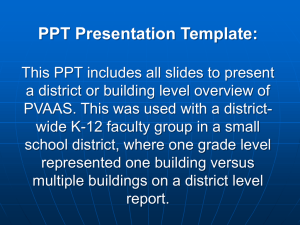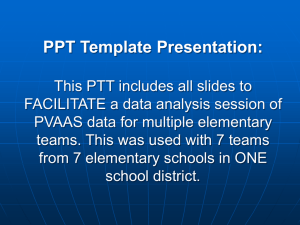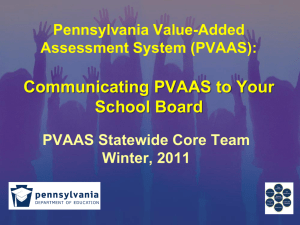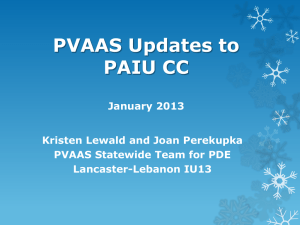Faculty Presentation 1
advertisement
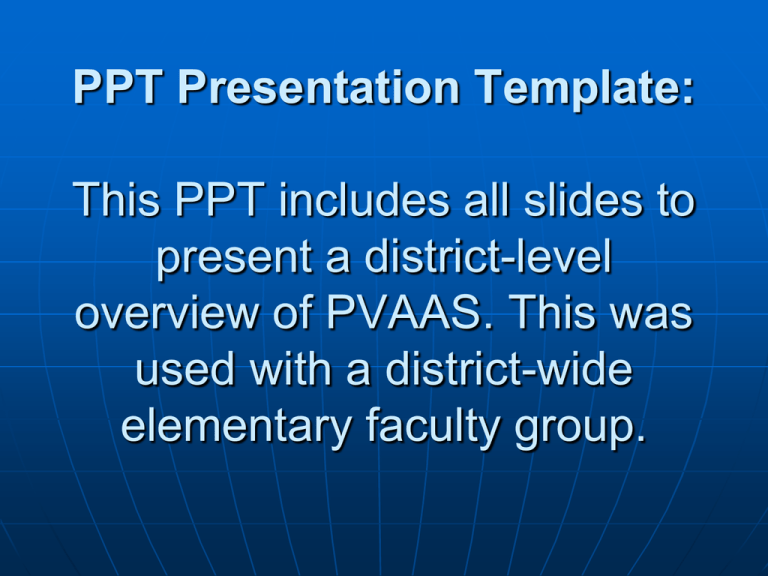
PPT Presentation Template: This PPT includes all slides to present a district-level overview of PVAAS. This was used with a district-wide elementary faculty group. PVAAS Overview: Evaluating Growth, Projecting Performance Faculty Introduction PVAAS IS: • Analysis of existing assessment data – Longitudinal PSSA scores in available content areas • Math, Reading, Science, Writing – Provides reliable estimates • A measure of a school’s effectiveness • Critical Relationship: Growth Data vs. Achievement Data PVAAS: • Is not another test • Is not a comparison of single test scores • Critical concept: Does not provide a measure of growth for an individual student Current Data Collection Approaches High Achievement Average Achievement Low Achievement Achievement is based on each student’s ending point. PVAAS Adds Another Variable To Achievement…Progress Below Growth Standard At or Above Growth Standard Progress is based on each student’s starting point. Viewing Achievement and Progress Together Scatter Plots: Grades 4-8 Reading and Math The Scatter Plot Coordinate System Vertical Axis PSSA Percent Proficient or Advanced Achievement and Growth - 4th Math % Proficient or Advanced AYP Percent Proficient Target Growth Standard Boundary One Year Growth 56 0 -20 0 PVAAS Growth Measure 20 Horizontal Axis PVAAS Growth Measure Scatter Plot Quadrants and Their Meanings Quad 2 Adequate Achievement Negative Growth Achievement and Growth - 4th Math % Proficient or Advanced Quad 3 Below Adequate Achievement Negative Growth Quad 1 Adequate Achievement Positive Growth 56 Quad 4 Below Adequate Achievement Positive Growth 0 -20 0 PVAAS Growth Measure 20 District Scatter Plots District vs. IU Region vs. State Math and Reading Grades 4 – 8 District Scatter Plot – Grade 4 District Scatter Plot – Grade 5 District Scatter Plot – Grade 6 District Scatter Plot – Grade 7 District Scatter Plot – Grade 8 Viewing Achievement and Progress Together Scatter Plots: Grade 11 Reading and Math Grade 11 Scatter Plots The PSSA-PVAAS Scatter Plots visually display the following data from the statewide distribution of PSSA results for the most current school year. Achievement • The mean predicted performance of the cohort. • The actual mean performance of all students in the state is displayed for reference Growth • School Effect ≈ Observed Mean – Predicted Mean • Standardized School Effect = School Effect relative to its error – displays degree of confidence The following two slides explain the meaning of each of the regions of an 11th grade scatter plot. The Scatter Plot Coordinate System for Grade 11 Vertical Axis Mean Predicted Scaled Score 2010 Mean Scaled Score Growth Descriptor Boundaries (±2SEs) Horizontal Axis Growth Measure in Standard Errors Scatter Plot Regions and Their Meanings for Grade 11 District Scatter Plot – Grade 11 The TWO Types of PVAAS Information Looking Forward/Planning… Looking Back/Evaluation… PVAAS Projection Reports For Individual Students and Cohorts of Students Value-Added Growth Reports For Cohorts of Students Today NO individual measure of student growth. . Student Projections PVAAS Reporting Projections to Basic, Proficient, and Advanced Math and Reading: 3 4 or 5 4 5 or 6 5 6 or 7 6 7 or 8 78 8 11 Grade Last Tested Writing: 35 45 58 68 78 8 11 Grade Last Tested Science: 34 4 NA 58 68 78 8 11 Grade Last Tested How do I know that the projection is accurate? The projection is precise, and is created using a model that has been reviewed and approved by four different peer review panels and the GAO (US Government Accountability Office). The most recent 2008 growth model proposal to USDOE includes information regarding the statistical model and projection reliability study. (http://www.ed.gov/admins/lead/account/growthmodel/pa/index.html) Recent studies have confirmed that the PVAAS projections (even as far as 3 years into the future) are more reliable at looking at the future performance of a student than the most recent PSSA score. PVAAS Student Projection Report PVAAS Projections for Groups of Students Student Search Identified Students Meeting Search Requirements District (Single Grade) Projection Summary Report – Grade 3 District (Single Grade) Projection Summary Report for Grade 3 to be inserted here District (Single Grade) Projection Summary Report – Grade 4 District (Single Grade) Projection Summary Report for Grade 4 to be inserted here District (Single Grade) Projection Summary Report – Grade 5 District (Single Grade) Projection Summary Report for Grade 5 to be inserted here District (Single Grade) Projection Summary Report – Grade 6 District (Single Grade) Projection Summary Report for Grade 6 to be inserted here District (Single Grade) Projection Summary Report – Grade 7 District (Single Grade) Projection Summary Report for Grade 7 to be inserted here District (Single Grade) Projection Summary Report – Grade 8 District (Single Grade) Projection Summary Report for Grade 8 to be inserted here Value-Added Wouldn’t it be great to know if you made at least one year’s growth with students last tested in grades 4-8 and in grade 11? Value-added Measure of Cohort Growth Grades 4 through 8 in Reading and Math • Comparison to a State Growth Standard • The Growth Standard specifies the minimal acceptable academic gain from grade to grade for a cohort of students. • The use of a Growth Standard creates the possibility that ALL schools can demonstrate appropriate growth. Four Important Issues Difference in scores in consecutive years. 1. Measuring Gain 2. Growth Standard 3. Comparing Scores from year to year Convert all scores to same scale – NCE scale 4. Estimating Achievement Combine current observed scores with all previous scores in students’ histories. Student Name Quiz 1 Test 1 Quiz 2 Project 1 Test 2 Test 3 Cum Possible 25 100 30 75 70 100 Percent Joe 20 97 23 72 65 55 83 Betty 14 76 27 65 56 56 73.5 Elizabeth 21 96 25 60 64 78 86 PVAAS Value-Added Growth Descriptors – Grade 4 – 8 Math and Reading The PA Growth Standard specifies the minimal acceptable academic gain from grade to grade for a cohort of students. The Growth Standard is met when the students in a school or district on average maintain their relative position when compared to the 2006 statewide distribution of student scores (2006 is the base year). Estimated mean NCE gain equal or greater than zero. There is evidence that the school has met or exceeded the Growth Standard. All schools can achieve this rating. Estimated mean NCE gain less than zero by one standard error or less. There is slight evidence that the school has not met the Growth Standard. Estimated mean NCE gain less than zero by between one and two standard errors. There is moderate evidence that the school has not met the Growth Standard. Estimated mean NCE gain more than two standard errors less than zero. There is significant evidence that the school has not met the Growth Standard. PVAAS District Report Grades 4 through 8 - Math and Reading What Value-added Gain Means! Cohort’s Achievement 6th grade 64.6 Cohort’s Achievement 5th grade 60.7 0 10 20 30 40 50 60 70 80 90 100 NCE Scale State Mean = 50 PVAAS Gain ≈ Change in position from 5th to 6th grade ≈ 64.6 – 60.7 ≈ 4.0 NCE points PVAAS School Report High School Math and Reading Science and Writing Based on a predictive methodology: A predicted score is calculated for each student; Mean of predicted scores is calculated for students in a cohort; Mean of observed scores of students in the cohort; School Effect is the difference between the Observed and the Predicted Scores. Writing, Science & Grade 11 Reading/Math Growth Descriptors Progress is defined by the district or school effect, which is a measure of the difference between observed performance and predicted performance. Progress is significantly above the progress of the average district in the state. Progress is not detectably different from the progress of the average district in the state. Progress is significantly below the progress of the average district in the state. PVAAS District Report Grades 11- Math and Reading Grades 4, 8 & 11 – Science Grades 5, 8 & 11 – Writing PVAAS Performance Diagnostic Report The Key is the RED Whisker! Growth Standard Methodology What the whiskers tell us… Exceeded Growth Standard; More than One Year’s Growth Green Met the Growth Standard; Made One Year’s Growth Yellow Growth Standard (One Year’s Growth) Below Growth Standard; Less than One Year’s Growth Rose Predictive Methodology What the whiskers tell us… ABOVE Expectations -Observed Score Was Greater Than Predicted Score NDD – No Detectable Difference Between Observed Score and Predicted Score Observed – Predicted (One Year’s Growth) BELOW Expectations -Observed Score Was Less Than Predicted Score Performance Diagnostic Report Greater Detail – based on % of students Click on Hot Keys for lists of students. Student Lists from Performance Diagnostic Reports PA’s Intent for PVAAS Another Tool for Continuous Improvement Measure of Growth to Add to Achievement/Status Measures Not to Be Used in Isolation PVAAS Help Menus PVAAS Help Menus are designed around Frequently Asked Questions that the Core Team and IU staff often receive. PVAAS Help Menus Each Help Menu is organized into 5 common sections: • Navigating: designed to help users navigate through the report and access all available features. • Understanding: designed to increase users’ understanding of the key pieces of the report, as well as general assistance with correct interpretation. • Interpreting: designed to help users gain a deeper understanding of the interpretation of the reports, including tips on analyzing the report for patterns and trends. • Using: designed to help users gain an understanding of how the report can be used with other data sources for various decisionmaking purposes. • Assistance: provides general information on the viewing and printing of reports, as well as state and IU points of contact. Questions and Feedback Questions: PVAAS Materials or Statewide Implementation pdepvaas@iu13.org 717-606-1911 PVAAS Report Web Site https://pvaas.sas.com www.pde.state.pa.us 333 Market Street Harrisburg, PA 17126

